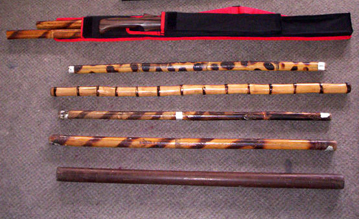While the knife was said to be the backbone of the Filipino martial arts (FMA), the stick is its most popular weapon hence arnis-escrima is always identified with stick fighting.
As a weapon, the stick is treated in varying ways among the many systems of FMA. In some schools, it is a mere training tool to teach the movements of the blade. In some FMA styles however, the stick is taught as a primary weapon.
The mechanics by which to create trauma with the stick is different from that of the blade according to Dan Inosanto. In his book “The Filipino Martial Arts” he wrote, “The old Filipinos who made stick fighting an art preferred to hit the bone and preferred a stick to a blade. Instead of a clean cut, the stick left a shattered bone”
The most popular material for escrima sticks is rattan, whose several varieties are abundant in the Philippines. Rattan is classified as a palm with stems 2-5 centimeters in diameter with long internodes between leaves. While outwardly similar to bamboo, rattan stems are not hollow but solid.
Rattan is the ideal material for escrima sticks because it is relatively light and could take a lot of punishment during hitting exercises. The number of nodes is of primary consideration when choosing a piece of rattan to be fashioned into a fighting stick.
The rule of thumb is the higher the number of nodes, the sturdier is the stick. The most popular variety of rattan for making fighting sticks is the labsica because of its high number of nodes.
Traditional escrima fighting sticks goes through a tedious process of fire hardening. A genuine hand-burned fighting stick is a fine impact weapon to own.
Besides rattan, the kamagong or ironwood is another popular material for fighting sticks in the Philippines. “Kamagong” is actually the term for the lumber of the Mabolo, a kind of tree with a hairy fruit. Famous for its dark color, kamagong is extremely dense and hard.
Within escrima circles, there are stories circulating on how the kamagong stick was used against bolos in real fights. Such anecdotes may have lead some to believe that the kamagong is the ultimate battle stick. But many old-school escrimadores preferred the rattan to a kamagong when fighting real duels because of its balance and maneuverability.
Though the kamagong can bash a skull with one stroke, it has a tendency to be brittle and splinter upon impact with another weapon because of its extreme density.
Rivaling the kamagong as a material for making heavy fighting sticks is the bahi. The bahi, often used as an axe handle in the Philippines, is taken from the outer core of the anahaw palm tree.
The leaf of the anahaw palm tree, which is also called by the same name, is the “national leaf” of the Philippines. It is commonly used to make pamaypay (fan) for the ladies.
The best bahi was said to be taken from trees, which was at least 35-years old. After extracting the bahi follows an elaborate process of priming the wood. A practice among Tagalogs is to soak the wood in mud for a week to remove its sap then it was rinsed and left to dry in a well-ventilated area away from direct sunlight.
The bahi was then cut to the desired length and sanded smooth. The last step was the repeated application of coatings of coconut oil to render the bahi waterproof.
Hardwood fighting sticks in the Philippines come rounded or flat. The latter is commonly referred to as “garote”.
I recently had the privilege to experience first hand the potency of Eskrima De Campo JDC-IO of Manong Ireneo “Eric” Olavides. Eskrima De Campo JDC-IO (The initials JDC-IO stands for “Jose D. Caballero,” and “Ireneo Olavides) is among the systems of FMA that teaches the stick as a primary weapon.
Olavides is the heir to the late legendary juego todo (all out stick fight) champion Grandmaster Jose D. Caballero. The style that had brought his teacher so many victories in juego todo matches is known as De Campo Uno-Dos-Tres Orihinal.
I would describe the strikes of Eskrima De Campo JDC-IO as precise and surgical. At the ripe age of 64, Olavides can still generate deadly precision, speed and power with his stick.
I have already seen many styles of stick fighting and I would say without reservation that Olavides’ method is the most efficient and effective I have seen so far. The following is the Eskrima De Campo JDC-IO organization’s general guidelines in choosing a fighting stick:
“De Campo practitioners never prescribed a standard sized stick. Sticks are cut according to the weight to length ratio. An inch of reach is sometimes sacrificed for optimum speed, accuracy and power. Stick lengths may vary from 31 inches to 26 inches.
The flight pattern of a De Campo strike although effective with heavier hardwood sticks, was developed basically to take advantage of the lightness and strength of the tough rattan stick.
While many of the strikes involve flywheel wrist action, GM Caballero had no trouble transitioning to live blade that he also practiced regularly. You will also note that the rattan sticks used by De Campo practitioners are unvarnished, without burned pattern accents and outer skin still left intact.”





















